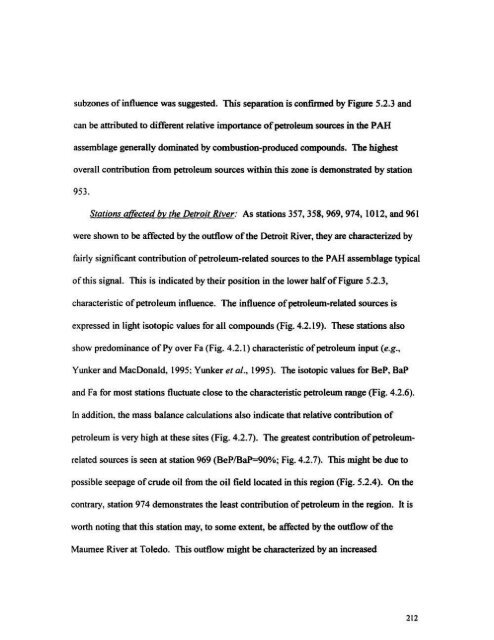I'r - Memorial University of Newfoundland
I'r - Memorial University of Newfoundland
I'r - Memorial University of Newfoundland
Create successful ePaper yourself
Turn your PDF publications into a flip-book with our unique Google optimized e-Paper software.
subzones <strong>of</strong>influence was suggested. This separation is confinned by Figure 5.23 and<br />
can be attributed to different relative importance <strong>of</strong>petroleum sources in the PAH<br />
assemblage generally dominated by combustion-produced compounds. The highest<br />
overall contribution from petroleum sources within this zone is demonstrated by station<br />
953.<br />
Stations affected bv the Detroit River: As stations 357, 358, 969, 974, 1012, and 961<br />
were shown to be affected by the outflow <strong>of</strong>the Detroit River, they are characterized by<br />
fairly significant contribution <strong>of</strong>petroleum-related sources to the PAH assemblage typical<br />
<strong>of</strong> this signal. This is indicated by their position in the lower half<strong>of</strong>Figure 5.2.3,<br />
characteristic <strong>of</strong>petroleum influence. The influence <strong>of</strong>petroleum-related sources is<br />
expressed in light isotopic values for all compounds (Fig. 4.2.19). These stations also<br />
show predominance <strong>of</strong>Py over Fa (Fig. 4.2.1) characteristic <strong>of</strong>petroleurn input (e.g.,<br />
Yunker and MacDonald, 1995; Yunker et al.; 1995). The isotopic value s for BeP, RaP<br />
and Fa for most stations fluctuate close to the characteristic petroleum range (Fig. 4.2.6).<br />
In addition. the mas s balance calculations also indicate that relative contribution <strong>of</strong><br />
petroleum is very high at these sites (Fig. 4.2.7). The greatest contribution<strong>of</strong>petroleum<br />
related sources is seen at station 969 (BeP!BaP=9O"/o; Fig. 4.2.7). This might be due to<br />
possible seepage <strong>of</strong>crude oil from the oil field located in this region (fig. 5.2.4). On the<br />
contrary, station 974 demonstrates the least contribution <strong>of</strong>petroleum in the region. It is<br />
worth noting that thi s station may, to some extent, be affected by the outflow <strong>of</strong>the<br />
Maumee River at Toledo. This outflow might be characterized by an increased<br />
212

















